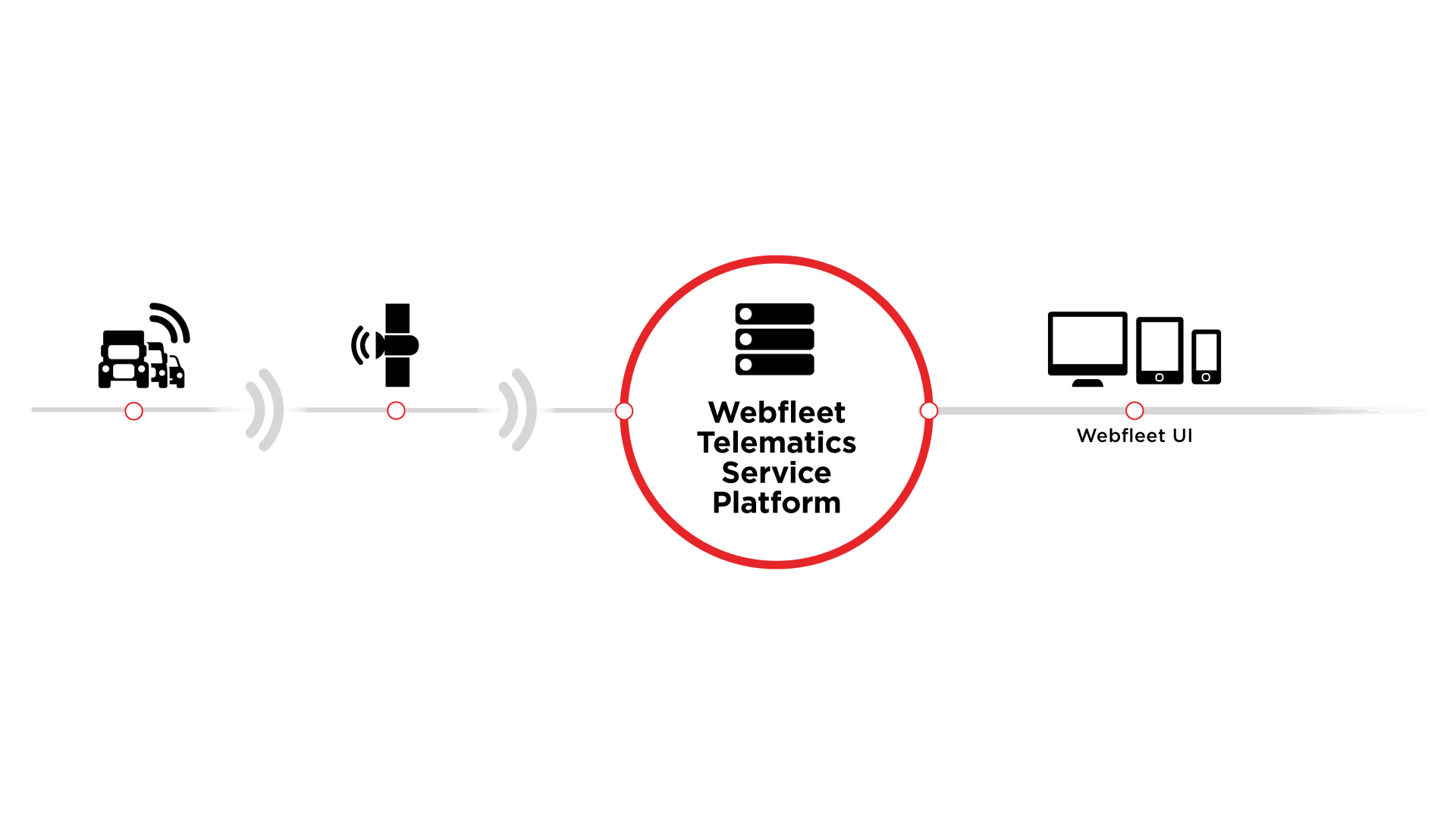





In this complete guide you can find information about:
- What is telematics?
- How does a telematics system work?
- What is a telematics device and how does it work?
- How can you use a telematics system for your fleet business?
- Why is telematics so key for trucking companies?
- What does the future of telematics look like?
What is telematics?
Telematics is a term that covers a number of different key technologies. It includes the various telecommunication devices that support the sending, receiving and storing of data, the devices integrated within vehicles that support vehicle tracking and control while they’re on the move, and satellite navigation and all of its applications. The word is now mainly used in the context of vehicle telematics, meaning the application of all of these technologies to road vehicles.
Telematics in fleet management
Telematics technology gives fleet managers full visibility of their operations. They can track vehicle locations, monitor driver behaviour and optimise routing and job planning - all in real time. Webfleet’s telematics solutions are designed to help fleets run more productively and efficiently.
What kind of industries use telematics for fleet management?
Telematics suits companies and organisations that use vehicles for their daily business. Delivery and maintenance services, construction and plumbing businesses, healthcare providers and passenger transport services: Fleets of all shapes and sizes rely on telematics to increase safety and operate more efficiently.
How does a telematics system work?

Telematics heavily relies on the use of wireless data-transmitting technologies such as cellular and satellite networks. It is thanks to worldwide access to these networks that telematics systems are able to function in a very precise and reliable way.
Telematics systems log location data from the vehicle’s GPS tracker, as well as diagnostic information collected in real time by the vehicle’s many on-board electronics. This information is then shared via one of the aforementioned wireless networks and sent to the internet servers that are responsible for their treatment and formatting.
Finally, the vehicle’s real-time data is transferred to a monitoring device or application where it’s displayed in a clear, easily digestible fashion. The use of telematics in a truck fleet allows for the real-time monitoring of a large number of vehicles, including their current location, the status of their on-board devices and their diagnostic data.
What is a telematics device and how does it work?
A telematics device (also called a black box) is a small electronic device that is installed in a vehicle to collect and transmit the vehicle’s performance data. The device works by using various sensors and GPS technology to track factors like a vehicle's location, speed and fuel consumption. Fleet managers can leverage such data to optimise vehicle performance, improve driver safety and reduce operational costs.
Where do you place/install a telematics device?
Telematics devices are typically installed in a vehicle's onboard diagnostic (OBD-II) port, usually located under the dashboard on the driver's side of the vehicle. Some telematics devices can be installed using an external power source and connected to the vehicle's wiring. Newer vehicles may come with built-in systems that are already integrated into the vehicle's electronics. Before installing a telematics device, it’s always good to consult with the device manufacturer or a professional installer on the best placement for your specific device.
Reducing insurance costs with telematics devices
Telematics helps reduce the chance for road incidents. With professional navigation, for instance, telematics ensures your drivers stay on the safest routes while avoiding construction zones, traffic jams and bad weather conditions. Improving your fleet’s safety record can lead to lower insurance costs. Some fleets choose telematics insurance policies, enabling insurance companies to base fees on safe driving scores.
What kind of data does a telematics device collect?

From vehicle locations to fuel consumption and driver behaviour, fleets generate a huge amount of potential data. With this data, fleet managers can assess driving behaviours like acceleration, speed and braking, all of which affect fuel consumption and vehicle condition.
Vehicle maintenance data is also collected, helping fleet managers resolve mechanical issues before they lead to costly repairs or downtime.
How do telematics devices and mobile apps work together?
Telematics is the combination of hardware and software that connects a vehicle to the internet and allows it to be monitored remotely. With apps, you can access the functionality of your fleet management software from your mobile phone. As with the desktop version of your fleet management system, you can easily monitor your fleet vehicles, know your driver status and dispatch orders.
Webfleet telematics devices and mobile apps
With the Webfleet Mobile app, fleet managers can run their fleets from their mobile phones. The vehicle tracking and safe-driving data collected by our telematics devices are transmitted to your fleet management account. All you need is an internet connection to access your real-time location and status data - you can operate your fleet on the go, from your mobile phone. Webfleet provides apps for drivers too: Work App simplifies daily task management and navigation; Logbook eliminates admin hassles with mileage tracking; Vehicle Check digitises daily vehicle inspections.
How can you use a telematics system for your fleet business?
A good telematics system offers many key benefits, helping you to:
- Know where your vehicles are 24/7
- Greater visibility over your fleet is the foundation to adaptability. Knowing your vehicle locations is key to asset security and reliable ETAs—you can assign jobs based on the nearest driver.
- Save on fuel and maintenance costs
- Efficiency is essential to fleet profitability. Improve your margins by reducing your fuel and maintenance costs. Telematics will help you stay on top of fuel consumption and preventative maintenance tasks.
- Optimise routes with better navigation
- Keep your drivers on the safest routes and away from construction zones, bad weather and congested areas. Satisfy customers with accurate updates and on-time delivery.
- Communicate better with your drivers
- Send order instructions from your office directly to your driver's PRO Driver Terminal. The terminal will then read the message out loud to the driver, minimising distractions so your drivers can focus on the road.
- Monitor and improve the behaviour or your drivers
- Could certain drivers benefit from coaching on safer, more fuel-efficient driving? Are your vehicles being used for personal trips? Your vehicle data will show whether any driver behaviour needs addressing.
- Manage compliance with driving time and mileage regulations
- Data quality matters for compliance. Count on reliable data, whether it’s from accurate odometer readings or automated trip reporting. Receive the highest level of data security for your business and your drivers.
These benefits have made telematics a key component of many well-functioning, profitable trucking businesses.
Which vehicles can a telematics system be used for?
Telematics systems can be used for various types of commercial vehicles. Fleets with cars, vans, trucks or buses use telematics to track their vehicles and other business assets. Construction companies also monitor the usage of their vehicles and equipment with telematics.
Why is telematics so key for trucking companies?
The constant aggregation of valuable real-time data from vehicles allows truck fleet managers to make smart adjustments and powerful improvements to their operation.
From scheduling to routing to driver management, there are lots of areas where telematics for trucks can help improve efficiency and productivity.
Telematics also greatly facilitate the job of the driver. It keeps them connected with their back office, allowing them to receive crucial updates, like accurate traffic information, at the soonest possible time. By connecting all the vehicles and people required to keep a truck fleet running effectively, telematics has brought a new and powerful approach to how fleets are managed.
What does the future of telematics look like?
The future of telematics is expected to bring significant advancements in the technology, such as the use of artificial intelligence to improve data analysis and decision-making. Additionally, the rapid adoption of electric vehicles (EVs) is increasing the demand for systems to monitor and optimise their performance. Telematics solutions play an important role in helping shape EV strategies, with insights that help fleets make the right decisions at the right times, both for EV procurement and ongoing management.
How Webfleet can help you with a telematics solution
A high-quality telematics solution like Webfleet gives you access to and control over your vehicle data, plus the tools and features your business needs to benefit from it. From planning your daily schedule to communicating with your team on the road, it can optimise every step of your vehicle management.
Your consent is required
In this section, external content is being embedded from .
To display the content, your consent is required for the following cookie categories:
- Targeted Advertising
- Analytics & Personalization
- Essential
For further details, please refer to our privacy policy. If you are interested in how ###vendor_name### processes your data, please visit their privacy policy.














